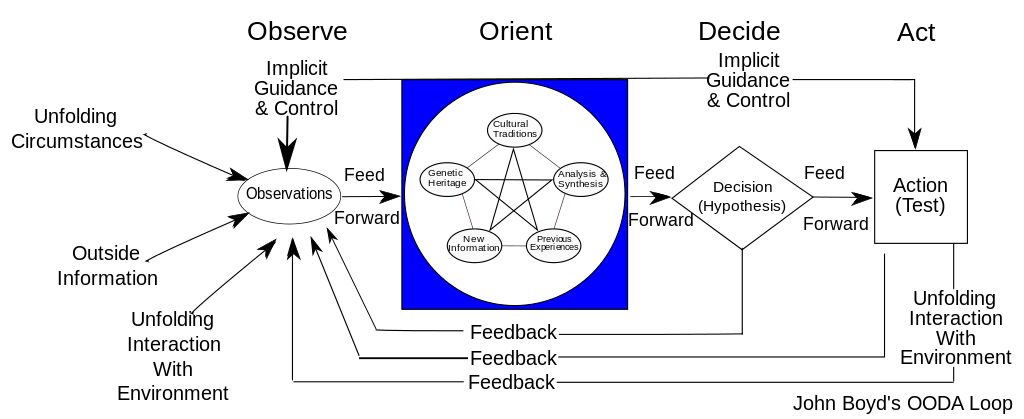“If I had it to do all over again”, or, “If I had only known then what I know now”… how often have you heard those sentiments, or perhaps even expressed them yourself? The lessons we learned in the “school of hard knocks” have become engraved on our brains in a way that no classroom lecture ever can. Yet, the trouble with learning by experience is that some endeavors are so costly in failure, that the student never gets a second chance to benefit from his mistakes. War is certainly such an endeavor. How many Alexanders and Napoleons might the world have known if only they had not died in their first attempt at battle? The sci- fi film, Edge of Tomorrow, postulates just such a scenario. In the film, Private Cage, played by Tom Cruise, is repeatedly killed in battle, only to be resurrected again just hours before the battle, to relive the events again. In the film, Cage begins as a bumbling idiot; however, contrary to Heraclitus, he treads in the same river again and again, each time benefiting form the lessons he learned previously, and eventually emerges the consummate warrior. I won’t spoil the plot for you by telling whether or not he single- handedly wins the war, and the heart of the pretty girl. All well and good in fiction, but until we find a way to resurrect departed soldiers, we must find a different way to train.
Early in the 1960s, Colonel John Boyd, a USAF fighter pilot, tried to determine the secret of successful fighter pilots. He devised the now- famous O.O.D.A. loop, with O.O.D.A. standing for Observe, Orient Decide and Act. The pilot first observes the enemy aircraft, orients himself to said aircraft, decides how to engage (or not) the aircraft, then acts on that decision. It is called a loop, because as the pilot’s action will have an effect on the enemy aircraft. He then starts over again, observing the effect, re- orienting to the enemy, deciding a new course of action, and acting. Boyd found that the pilot who could cycle through that loop faster than his adversary prevailed.
The problem with Boyd’s O.O.D.A. loop is that it is a little bit like saying, “to win a football game one must score more points than one’s opponent”. It describes accurately what must happen, without explaining how to bring it about. Most attempts at describing the ‘how’, have done so by inserting a series of flow charts between the steps of O.O.D.A. It is as if the pilot is flying along with a series of simple plans in his mind; ‘if I observe the enemy in front execute plan A, if he is above me plan B, if behind me plan C’ , etc. In practice, the flow chart method for an Infantry man might look something like this:
Imagine a foot patrol is tasked with clearing a route; say, for example, a logging road through the woods. Along the way, the point man Observes that he is taking fire. He furthermore Observes that the people shooting at him are indeed wearing enemy uniforms. He then Orients himself to the enemy using the flow chart. Is the enemy closer than hand grenade range? Yes? No? Are there any barriers between him and the enemy? He decides the answer to both questions is yes; therefore, he decides to direct the squad to assault through the ambush. Having made that decision, he Acts on it. He then Observes the result, starting the process over again.
This is all well and good for developing a classroom understanding, but flow charts are too cumbersome for critical decisions that must be made instantaneously. The above- described squad would be annihilated by any halfway- skilled enemy, before the point man made it to the decision part of the process.
Enter a contemporary researcher, Gary Kline, who studied firefighters and neonatal nurses, among others, to understand how people make important decisions under pressure of time. He found that these professionals, and others like them, based their decisions, not on any flow chart, but on past experience. One example he outlines is of a firefighter, who must rescue a woman hanging on a ledge over a busy freeway. Based on his past experience, he knows he does not have the time stop traffic and reach her with a ladder, and so decides, also based on experience, that he can lower a rescuer on a rope from above. It is noteworthy that the firefighter in this story went through the O.O.D.A loop process, he just did not use the flow chart method of decision making; rather he recognized similarities to his past experience, and acted upon those experiences. Kline calls this “recognition primed decision making”.
Let’s look at our infantry patrol above, from a recognition based decision making model. The point man begins leading his patrol along the logging road, as his orders prescribe. As the patrol travels down the road, it becomes more and more sunken, until it begins to resemble a ravine. The point man begins to have a bad feeling about his route, because it resembles a place where he had conducted a successful ambush against an enemy patrol. With this on his mind, he spots two enemy soldiers lying in the tall weeds at the edge of the ravine to his left. The point man instantly recognizes that his squad has assaulted similarly sized forces across similar terrain with success in the past. He eminently opens fire, while shouting to his buddies, “Ambush left, 20 meters!” The rest of the squad, having been through this before, needs no elaborate explanation, but rushes through the enemy position with alacrity.
Again, our hypothetical patrol goes though the O.O.D.A. loop process, but, due to their past experience, they do so much more quickly. As Boyd found, he who OODA’s first, wins. Kline’s work found that the more experienced individuals make better decisions faster than less experienced people. That should come as a shock to no one. This brings us back to Private Cage from Edge of Tomorrow, and the question: how do we give someone experience without killing him in the process?
One answer is to simulate the experience. This immediately brings to mind million dollar flight simulators, and other training aids. As useful as these methods are, simulation is much older, and far simpler. Simulation can be as simple as two boxers sparing at 1/3 power, thus allowing them to learn the lessons of boxing without getting seriously hurt in the process. Long before any scientist studied these things, children were practicing war with games. Tag, hide- and- seek, and red rover are all war games. The nature and value of authentic simulation is a topic for another post, but with a force on force simulation, you really can do it all over again.


“Gödel’s Proof indirectly shows that in order to determine the consistency of any new system we must construct or uncover another system beyond it. The consistency of the concept and the consistency of the match-up between observed reality and concept description of reality. In this sense, if we assume — as a result of previous destructive deduction and creative induction efforts — that we have a consistent concept and consistent match – up, we should see no differences between observation and concept description. Yet, as we have seen, on one hand, we use observations to shape or formulate a concept; while on the other hand, we use a concept to shape the nature of future inquiries or observations of reality. Back and forth, over and over again, we use observations to sharpen a concept and a concept to sharpen observations. Under these circumstances, a concept must be incomplete since we depend upon an ever-changing array of observations to shape or formulate it. Likewise, our observations of reality must be incomplete since we depend upon a changing concept to shape or formulate the nature of new inquiries and observations. Therefore, when we probe back and forth with more precision and subtlety, we must admit that we can have differences between observation and concept description; hence, we cannot determine the consistency of the system — in terms of its concept, and match – up with observed reality — within itself. Furthermore, the consistency cannot be determined even when the precision and subtlety of observed phenomena approaches the precision and subtlety of the observer — who is employing the ideas and interactions that play together in the conceptual pattern. This aspect of consistency is accounted for not only by Gödel ‘s Proof but also by the Heisenberg Uncertainty or Indeterminacy Principle.”
“Examination of Heisenberg’s Principle reveals that as mass becomes exceedingly small the uncertainty or indeterminacy, becomes exceedingly large. Now — in accordance with this relation — when the precision, or mass, of phenomena being observed is little, or no different than the precision, or mass, of the observing phenomena the uncertainty values become as large as, or larger than, the velocity and size frame-of-reference associated with the bodies being observed. In other words, when the intended distinction between observer and observed begins to disappear the uncertainty values hide or mask phenomena behavior; or put another way, the observer perceives uncertain or erratic behavior that bounces all over in accordance with the indeterminacy relation. Under these circumstances, the uncertainty values represent the inability to determine the character or nature (consistency) of a system within itself. On the other hand, if the precision and subtlety of the observed phenomena is much less than the precision and subtlety of the observing phenomena, the uncertainty values become much smaller than the velocity and size values of the bodies being observed. Under these circumstances, the character or nature of a system can be determined — although not exactly — since the uncertainty values do not hide or mask observed phenomena behavior nor indicate significant erratic behavior.” ~ John Boyd
Its not just about OODA faster than your enemy, its about accurate Orientation phase that enables effective decisions. If the Orientation phase is weak the decisions are in-effective and thus a poor action phase occurs. Simply put better decisions faster are better than faster decisions.
“Orientation is the Schwerpunkt. It shapes the way we interact with the environment – hence orientation shapes the way we observe, the way we decide, the way we act, Orientation shapes the character of present observation-orientation-decision-action loops – while these present loops shape the character of future orientation” —John Boyd, Organic Design for Command and Control
I don’t pretend that this one page post is anything but a gross oversimplification of these two concepts, both of which have had multiple books written about them.
As to Orientation being the main emphasis, far be it from me to disagree with Boyd; however, in my observation, most beginners get hung up on the decision, rather than the orientation. Better decisions faster ARE better than faster decisions, but any decision executed quickly is better than a perfect decision executed too late.
We will never have all of the data we want to make a decision, in the time we need to make it in. The art is in knowing when you have enough of the critical parts to make a decision. Larsen’s article on the 70 percent solution is a good discussion of this. https://warnerds.com/?p=261 I say “art” because we are using a quantifiable figure, 70%, to describe a non-quantifiable concept. Having 70% of the necessary data is a bit like saying a girl is 70% pretty: how can we know that? But, as in all arts, skill is built through experience. First we get a student to make a decision, any decision, then he sees his failure points. Quite often, these are caused by his failure to orient realistically, so he goes on to make better decisions later.